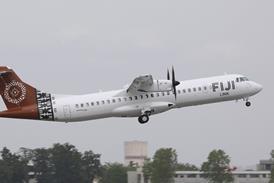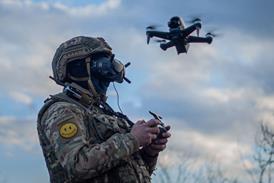
Max Kingsley-Jones/SINGAPORE
Airbus Industrie may have just allowed its A3XX high capacity airliner programme to slip by almost a year, but it remains committed to the initiative to provide a European alternative to Boeing's long term monopoly of the market. There are hurdles to cross during 1998, however, before Airbus can be comfortable enough with its performance promises to launch the programme and firm up the 2004 in-service target.
Boeing and Airbus have both had their share of headaches over the last 12 months with their plans for new high capacity aircraft. A year ago, just as it seemed poised to launch a major new family of 460- to 550-seat 747 derivatives - the -500/600X - Boeing decided to cancel the $7 billion programme, seemingly leaving the market wide open to Airbus. The US manufacturer made the decision in part because of its stated concern over the potential size of the market for such an aircraft, and is now discussing an array of cheaper, simpler, 747-400 derivatives. The European consortium remains committed to its all-new, $9 billion, A3XX programme.
The A3XX plans, which crystallised into the current baseline double-deck 550-seat format around four years ago, are being developed with some 19 of the world's major airlines, 40 major airports and industrial partners and suppliers. Despite the Boeing U-turn, and concerns in some sectors of the industry that the market will not be as large or emerge as quickly as Airbus is forecasting, the consortium "-isn't blinking in its discussions with the airlines", remarks one industry observer.
PIERSON WARNING
Despite this determination, outgoing Airbus president Jean Pierson has warned that the launch should not be made until the consortium is satisfied that the programme can meet its promised target of delivering significantly better economies than those of the Boeing 747. Pierson says that the decision to delay the programme was taken in late 1997 as Airbus "had not achieved the engineering target" of producing a step change in operating economics. Although Pierson believes that the outstanding technical issues will be resolved by the end of this year, he warns that, if Airbus is still not satisfied that the goals can be achieved, then he will recommend a further delay.
Airbus has set a baseline requirement for the A3XX to achieve direct operating cost (DOC) savings per seat of 15-20% over those of the current 747-400. The delay was instigated when it became clear that Airbus would not be ready to launch the aircraft by the end of 1998 as it was not far enough along the development cycle to be sure that it could offer these efficiency gains. The decision to launch, which had been expected in late 1998, is not now expected until at least the third quarter of 1999.
Another issue has been a lack of engineering resources caused by the programme's clash with the build-up to the launch of the A340-500/600 at the end of 1997. Airbus had originally been planning to launch the new A340 programme a year earlier, but this was effectively delayed by the collapse of an agreement with General Electric to provide the engines.
Speaking at the Royal Aeronautical Society in the UK earlier this year, Airbus Industrie vice-president for forecasting and strategic planning Adam Brown outlined some of the critical issues that Airbus is still working to resolve. "We are working on computer based modelling of the difficult to predict aero-elastic behaviour of such large structures. The aircraft's great mass and moments of inertia are likely to require some further advance in flight control technology," he said.
Brown also spoke of the challenge to achieve the promised efficiency gains. "A340 levels of technology, together with economies of scale, would result in DOC per seat about 10% lower than the 747-400's," he said. Airbus will have to find significant further savings from new technologies to reduce weight, fuel consumption, maintenance cost and cost of ownership, he says, to meet the target of more than 15%. External noise levels and emergency passenger evacuation are other issues, says Brown.
PRELIMINARY DESIGN FREEZE
Philippe Jarry, vice-president for market development in the Large Aircraft division of Airbus, says that the consortium now has 120 people working on the A3XX project within the division and a further 250 with the partner companies. A preliminary design freeze was made "pretty much on schedule" on 22 January, says Jarry, who adds that low speed windtunnel testing is about to begin which will enable the wing's high lift systems to be defined. A final configuration freeze is scheduled for the end of 1998.
In the meantime, Airbus submitted an application to the European Joint Aviation Authorities for A3XX type certification which "will enable detailed discussions to begin with the authorities before we move from the concept phase to detailed definition," says Jarry.
Partners and suppliers are bidding for the various industrial production packages. These should be finalised before the end of the year, along with issues of production method and assembly line location. The sheer size of A3XX subassemblies means that Airbus is having to take a new look at its production and assembly.
Jarry says that, with the technical and production issues elements resolved, firm offers can be made to airlines during the first half of 1999, followed by a launch in the third quarter. Flight testing will start in mid-2003 with service entry due to follow about15 months later.
Airbus says that up to 40% of the A3XX programme could be awarded to new risk-sharing partners, although Pierson denies suggestions that there are insufficient partners signed up. He is adamant that existing agreements cover the programme by "more than 100%". Those signed include Alenia, Belairbus, Finavitec, Fokker (Stork) and Saab. A sixth, undisclosed, European company has joined the programme, says Jarry, while Spain's CASA, which has a 4.2% stake in Airbus, is keen to increase its involvement.
Airbus already has an agreement with Rolls-Royce for the development of a Trent derivative, the 900, for the A3XX in the 280-350kN(64,000-80,000lb) thrust class, and a similar agreement is being discussed with General Electric Pratt & Whitney Engine Alliance.
The baseline A3XX is dubbed the -100, seating 555 passengers in a three-class layout and able to operate over ranges of 14,200km (7,650nm). This model weighs in at 540t maximum take-off weight (MTOW), and Airbus already has firm plans for a stretched656-seat 583t MTOW -200, and a version of the -100 featuring the -200's weights and additional fuel capacity offering around 2,000km more range.
SHORT FUSELAGE MODEL
Airbus has recently firmed up the definition of a new, short fuselage, version, dubbed the A3XX-50, which seats 480 passengers, and features lower weights and engine thrust, as well as a 5.1m reduction in fuselage length. The new model has been conceived to plug the gap between the 378-seat A340-600 and the 555-seat A3XX-100, and as a rival to any stretched Boeing 747. For the longer term, Jarry envisages further size and weight growth, with up to 650t MTOW being required for further increases in range, or perhaps an even larger, 750-seat, "-300" version.
Airbus is planning freighter (-100F) and combi (-100C) versions, which will feature a main-deck 3.43 x 2.54m cargo door in the aft fuselage. The freighter will also be equipped with a cargo door on the upper deck in the forward fuselage. The -100C will have the capacity for up to 15 2.4 x 3.2m cargo pallets in the aft main deck, while the full freight variant will be able to carry up to 57 pallets on three cargo decks.
Airbus has clearly established a firm outline of the A3XX's family tree, some years before the aircraft is due to enter service. It must now resolve the outstanding engineering and logistical issues to enable the seeds to be planted.
Source: Flight International























